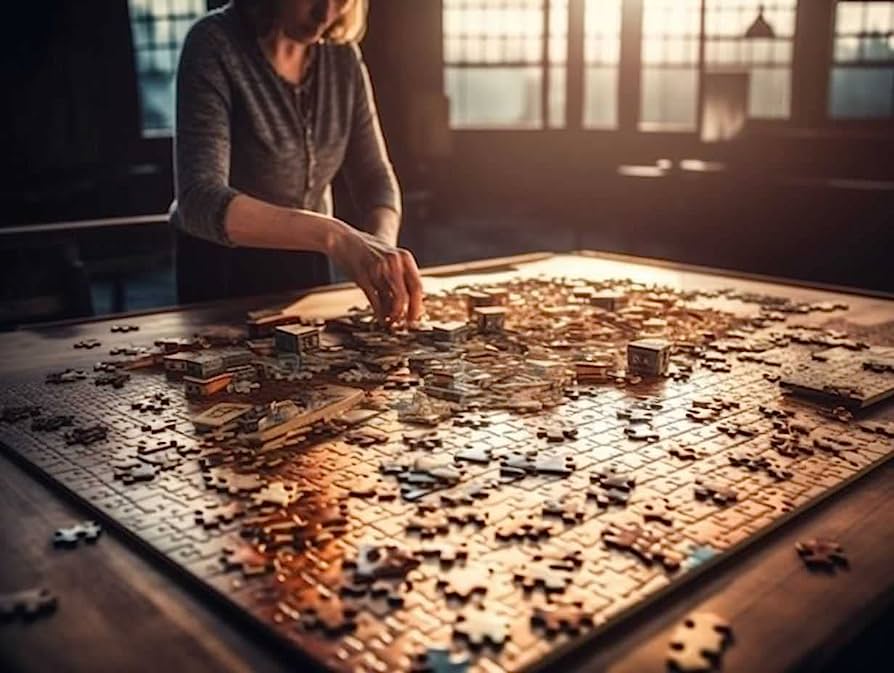Jigsaw puzzles have been captivating minds and bringing joy to people of all ages for centuries. These delightful brain teasers have evolved from simple wooden creations to intricate, digital masterpieces. As we explore the history of jigsaw puzzles, we will dive into their origins, their different types, materials used throughout history, and their contemporary significance in today's society.
The Origins of jigsaw puzzles find their roots in maps, educational tools, and artistic endeavors. The earliest form of jigsaw puzzles appeared in the 18th century when cartographers pasted maps onto wooden boards and cut them into pieces with a jigsaw (a handheld, mechanical saw with fine teeth). These "dissected maps" aimed to teach geography in a playful manner.
In 1760, John Spilsbury, a London-based engraver and mapmaker, created the first true jigsaw puzzle. He mounted a map on a thin piece of wood, cut it into pieces following the boundaries of countries and regions, and named it the "Map-Dissected." It gained immense popularity as a learning tool and entertainment, laying the foundation for the modern jigsaw puzzle.
Throughout the 19th century, jigsaw puzzles underwent several transformations, from being purely educational to becoming a widespread form of entertainment. By the mid-1800s, puzzle enthusiasts started using illustrations instead of maps, incorporating images of landscapes, famous artworks, and other engaging visuals. Advances in printing technology allowed for more intricate and detailed images.
Around the same time, the die-cutting technique emerged, replacing the earlier method of hand-cutting puzzles. This innovation streamlined production and made puzzles more accessible to the general public. The pieces became more uniform in shape, enhancing the challenge and overall experience of assembling the puzzle.
In the early 20th century, puzzles experienced a surge in popularity, becoming a widespread pastime during the Great Depression. Their affordability and ability to provide hours of entertainment made them an attractive form of escapism during difficult times.
Over time, various types of jigsaw puzzles emerged to cater to different interests and preferences:
-
Standard Jigsaw Puzzles: These puzzles feature a traditional interlocking grid of irregularly shaped pieces. They come in various sizes, ranging from small and straightforward puzzles for children to larger and more complex ones for experienced puzzlers.
-
3D Puzzles: With the advent of technology, 3D puzzles gained popularity. They offer a unique challenge, requiring participants to assemble structures and models, often depicting famous landmarks or buildings.
-
Mystery Puzzles: Mystery or hidden-image puzzles present an added layer of difficulty. The image on the box cover might not entirely match the puzzle's final picture, adding an element of surprise and intrigue.
-
Multi-layered Puzzles: These puzzles consist of several layers that stack on top of each other, creating a three-dimensional effect. They often depict historical scenes, cityscapes, or geological formations.
-
Photomosaic Puzzles: Photomosaics use thousands of smaller images to create a larger picture, often creating a stunning and unique overall image.
-
Puzzleball: A spherical version of the traditional puzzle, puzzleballs require participants to assemble curved plastic pieces to form a globe or other round objects.
-
Personalized Puzzles: In recent years, personalized puzzles have gained popularity, allowing individuals to create puzzles using their own photos or artwork.
The materials used in crafting jigsaw puzzles have evolved alongside technological advancements:
-
Wood: Early jigsaw puzzles were typically made from wood. Wooden puzzles still hold a special appeal for enthusiasts who appreciate the tactile experience and the classic charm of these puzzles.
-
Cardboard: Cardboard puzzles became the industry standard due to their cost-effectiveness and ease of production. Cardboard pieces are durable, lightweight, and easily recyclable, making them an eco-friendly option.
-
Plastic: In the mid-20th century, plastic puzzles gained popularity, especially for children's puzzles, as they are more resistant to wear and tear.
-
Foam: Foam puzzles are designed for young children, offering safety with their soft and pliable pieces.
In the digital age, jigsaw puzzles continue to captivate people and have found a new place in modern society:
-
Cognitive Benefits: Jigsaw puzzles stimulate the brain and improve cognitive functions, such as problem-solving, spatial awareness, and critical thinking. They challenge both sides of the brain and help enhance memory retention and concentration.
-
Stress Reduction: Engaging in jigsaw puzzles can have a calming effect on the mind. The focused, repetitive nature of piecing together a puzzle can reduce stress and anxiety, promoting relaxation and mindfulness.
-
Social Interaction: Jigsaw puzzles provide an excellent opportunity for social bonding. Assembling a puzzle with family or friends fosters teamwork, communication, and a sense of accomplishment when the puzzle is completed together.
-
Educational Tool: Jigsaw puzzles continue to serve as valuable educational tools, helping children learn about shapes, colors, and develop problem-solving skills.
-
Digital Puzzles: The rise of digital jigsaw puzzles has allowed people to enjoy puzzles on various devices. Digital puzzles offer additional features like adjustable difficulty levels, virtual collaborations, and access to a vast library of images.
From their humble origins as educational tools to the wide range of variations and materials available today, jigsaw puzzles have come a long way. These timeless brain teasers have continued to evolve and adapt, maintaining their relevance and charm in the modern era. Whether it's the joy of completing a challenging puzzle or the sense of accomplishment that comes with seeing the final image emerge, jigsaw puzzles hold a special place in the hearts of millions around the world. As we look to the future, it is safe to say that the allure of jigsaw puzzles will endure for generations to come.

